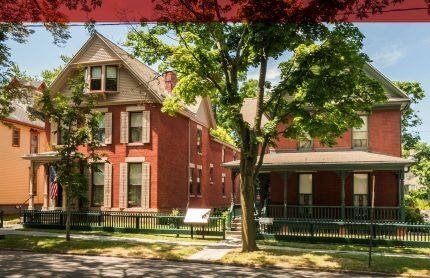
Frederick Douglass Tour
Frederick Douglass was one of the most renowned human rights leaders of the nineteenth century. A brilliant orator and author, Douglass was at the forefront of the abolitionist movement and became the first black citizen to hold a high rank in the United States government.
Born into slavery in 1818, he escaped to freedom in 1838 and settled in Rochester, New York, from 1847 until 1872. It was in Rochester that Douglass completed some of the most significant work of his career, including publishing The North Star newspaper, assisting in Underground Railroad activities, and working with Susan B. Anthony and Elizabeth Cady Stanton in support of woman suffrage. According to Douglass, he “found no soil better” to pursue his efforts for social reform and opted to reside in Rochester longer than he had in any other location.
Visitors to Rochester today can embark on a self-guided tour tracing Douglass’ legacy throughout the region. Locations significant to his life and work have been marked by thirteen life-sized replica statues of the Frederick Douglass Monument, the original of which can be found in Rochester’s Highland Park. Each statue installation includes a QR code that, when scanned, brings viewers to a website with more information on the importance of the site and the Douglass legacy.
Sites on the tour include:
The Talman Building, 25 East Main Street (currently vacant). Publishing site for The North Star and The Frederick Douglass Newspaper. Walk up visitation only; a bronze plaque commemorating Douglass’ life and work can be viewed on the side of the building.
Former site of AME Zion Church, 42 Favor Street (currently the site of the Greater Bethlehem Temple). Original site where The North Star was published, and a stop on the Underground Railroad.
999 South Avenue (currently School #2). Former site of the Douglass Family Farm.
50 Plymouth Avenue North (currently the site of the Hochstein School of Music and Dance). Site of Douglass’ funeral in 1895.
Intersection of Central Avenue and St. Paul Street. Original location of the Douglass Monument, currently located in Highland Park.
Corinthian Street (formerly Exchange Place), just east of State Street. Site of Douglass’ renowned Fourth of July speech.
300 Alexander Street (currently Alexander Apartments). Near the site of Douglass’ first home in Rochester at 297 Alexander Street.
Intersection of Alexander Street and Tracy Street. The Seward School, attended by Douglass’ children.
Kelsey’s Landing in Maplewood Park. Underground Railroad departure point.
1133 Mount Hope Avenue, Mount Hope Cemetery. Burial site of Douglass and members of the Douglass Family. Find more information on cemetery tours here.
Washington Square Park. Site of Civil War “Soldiers and Sailors” Monument.
University of Rochester Rush Rhees Library. Commemorating Douglass’ work in Rochester and repository for the Frederick Douglass Papers. Find more information on the Frederick Douglass Project at the University of Rochester here.




